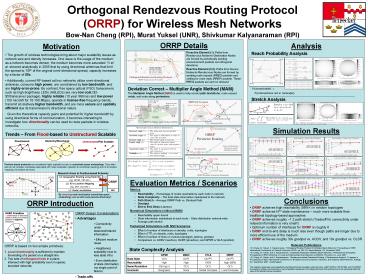Deviation Correct Multiplier Angle Method MAM - PowerPoint PPT Presentation
1 / 1
Title:
Deviation Correct Multiplier Angle Method MAM
Description:
ORRP achieves N3/2 state maintenance much more scalable than traditional ... (FSO) transceivers such as high-brightness LEDs (HBLEDs) are very low cost ($2-$5 ... – PowerPoint PPT presentation
Number of Views:37
Avg rating:3.0/5.0
Title: Deviation Correct Multiplier Angle Method MAM
1
Orthogonal Rendezvous Routing Protocol (ORRP) for
Wireless Mesh Networks Bow-Nan Cheng (RPI),
Murat Yuksel (UNR), Shivkumar Kalyanaraman (RPI)
ORRP Details
Analysis
- Motivation
- The growth of wireless technologies bring about
major scalability issues as network size and
density increases. One issue is the usage of the
medium as a network becomes denser, the medium
becomes more saturated. Yi et al. showed
analytically in 2005 that by using directional
antennas that limit the spread to 1/8th of the
original omni-directional spread, capacity
increases by a factor of 50x. - Additionally, current RF-based ad hoc networks
utilize omni-directional antennas, consume high
power, are constrained by low bandwidth, and are
highly error-prone. By contrast, free space
optical (FSO) transceivers such as
high-brightness LEDs (HBLEDs) are very low cost
(2-5/transceiver package), highly reliable (10
year lifetime) and low power (100 microW for
10-100 Mbps), operate in license-free frequency
bands, transmit at relatively higher bandwidth,
and are more secure and spatially efficient due
its transmissions directional nature. - . Given the theoretical capacity gains and
potential for higher bandwidth by using
directional forms of communication, it becomes
interesting to investigate how directionality can
be used to route packets in wireless networks.
Reach Probability Analysis
Proactive Element (1) Paths from Rendezvous
Nodes-to-Destination Nodes are formed by
periodically sending announcement packets out
orthogonal directions
Reactive Element (2,3) Paths from Source
Nodes-to-Rendezvous Nodes are formed by sending
route request (RREQ) packets and waiting for
route reply (RREP) packets. These RREQ packets
are sent on demand
Deviation Correct Multiplier Angle Method (MAM)
Punreachable Pintersections not in
rectangle
The Multiplier Angle Method (MAM) is used to help
correct path deviations, route around voids, and
route along perimeters.
Stretch Analysis
Simulation Results
Trends From Flood-based to Unstructured Scalable
Hierarchy/Structured
Flood-based
Unstructured/Flat Scalable
Position-based protocols are considered highly
scalable but rely on coordinate space embeddings.
They often also do not consider overheads
associated with node localization (position to
coordinate mapping) and ID to location mapping
(via location services).
Research Areas in Position-based Schemes
(15,5)
Evaluation Metrics / Scenarios
(4,6)
D
(8,5)
S
D(X,Y)?
(0,4)
(12,3)
Metrics
- Reachability Percentage of nodes reachable by
each node in network - State Complexity The total state information
maintained in the network - Path Stretch Average ORRP Path vs. Shortest
Path - Goodput
- End to End Delay (Latency)
(5,1)
By removing node localization (coordinate space
embedding), can we still route packets
effectively?
- Conclusions
- ORRP achieves high reachability (98) in random
topologies - ORRP achieves N3/2 state maintenance much more
scalable than traditional topology-based
approaches - ORRP achieves roughly 1.2 path stretch
(Tradeoff for connectivity under relaxed
information is very small!) - Optimum number of interfaces for ORRP is roughly
8 - ORRP end-to-end delay is much less even though
paths are longer due to more efficient use of the
medium - ORRP achieves roughly 30x goodput vs. AODV, and
10x goodput vs. OLSR
ORRP Introduction
Numerical Simulations (without MAM)
ORRP Design Considerations
- ORRP Primitive
- Local sense of direction
- leads to ability to forward
- packets in opposite
- directions
Rendezvous Points
A
- Reachability upper bound
- State information maintained at each node State
distribution network-wide - Average path stretch
- Advantages
- Connectivity under lessened/relaxed information
- Efficient medium reuse
- Heightened scalability (due to less state info)
- Even distribution of state information (no
single point of failure) - Trade-offs
- Path inefficiency (not always shortest path)
Packetized Simulations with NS2 Scenarios
- Effect of number of interfaces on density, voids,
topologies - Effect of TTL on density, voids, topologies
- Effect of number of lines on various topologies,
latency, goodput - Comparison vs. AODV (reactive), OLSR (proactive),
and GPSR w/ GLS (position)
B
- Relevant Publications
- B. Cheng, M. Yuksel, S. Kalyanaraman,
"Orthogonal Routing Protocol for Wireless Mesh
Networks," Proceedings of IEEE International
Conference on Network Protocols (ICNP), pp
106-115, Santa Barbara, CA, November 2006. - B. Cheng, M. Yuksel, and S. Kalyanaraman,
Directional Routing for Wireless Mesh Networks A
Performance Evaluation, Proceedings of IEEE
Workshop on Local and Metropolitan Area Networks
(LANMAN), Princeton, NJ, June 2007. - B. Cheng, M. Yuksel, and S. Kalyanaraman,
Rendezvous-based Directional Routing A
Performance Analysis, To appear in Proceedings
of IEEE International Conference on Broadband
Communications, Networks, and Systems
(BROADNETS), Raleigh, NC, September 2007.
(invited paper) - This material is based upon work supported by the
National Science Foundation under Grant Nos.
IGERT 0333314, ITR 0313095, and STI 0230787. Any
opinions, findings, and conclusions or
recommendations expressed in this material are
those of the author(s) and do not necessarily
reflect the views of the National Science
Foundation.
- ORRP is based on two simple primitives
- Local directionality is sufficient to maintain
forwarding of a packet on a straight line - Two sets of orthogonal lines in a plane intersect
with high probability even in sparse, bounded
networks
State Complexity Analysis






























